Old Guard Taxi Industry Finds Tough Times in Japan
Tradition is no stranger to the Captain. After enjoying a few drinks and the pleasant company of a few lovely ladies at a Kabukicho hostess club, a trip to a nearby massage parlor is an almost certainty. Tradition, plain and simple.
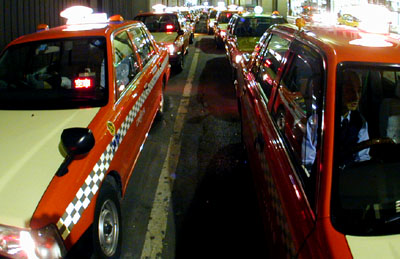 Taxi companies are no different. A lack of competition in the industry has left their primary means of doing business mostly unchanged since World War II. This week the Captain focuses on how last year's deregulation enactments are changing Japan's taxi business. Jump in his backseat as he plays tour guide for this industry in transition.
Taxi companies are no different. A lack of competition in the industry has left their primary means of doing business mostly unchanged since World War II. This week the Captain focuses on how last year's deregulation enactments are changing Japan's taxi business. Jump in his backseat as he plays tour guide for this industry in transition.
She later found out it was because of a pachinko windfall of 300,000 yen. But the reason didn't matter.
"It was the biggest fare of my career," recalls Setsuko Ugajin of a passenger who rented her taxi for a day of touring the hot springs of the resort town of Hakone.
But the days of passengers dropping 40,000 yen for a joyride died with the burst of Japan's asset-inflated bubble economy over a decade ago. Today even just getting passengers is proving tough, and getting tougher.
Not only is Japan's recession crimping demand, but enactments instituted as a part of a deregulation plan last year by the government are bringing true competition - a concept that will take some time in getting used to for this traditionally coddled industry.
In taking a look around Japan, overcapacity can be seen everywhere by the excessive number of convenience stores, banks, gas stations, and factories filling big cities and lining the countryside. The economic monster that is Japan Inc. has spurned optimization in favor of glut by spreading its tentacles far and wide, choking off profits in all but a few select industries.
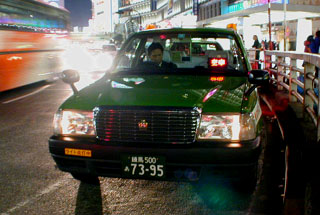 The taxi industry - equally famous for its automatic doors as its oft-directionless drivers - exemplifies this concept perhaps more visibly than any other.
The taxi industry - equally famous for its automatic doors as its oft-directionless drivers - exemplifies this concept perhaps more visibly than any other.
On any given day in Kanagawa Prefecture's city of Fujisawa, multiple lines of customer-seeking taxis - some exceeding 50 cars - snake away from both sides of the main train station and on down side streets. In between inching forward small increments as each passenger is picked up at the front, drivers can be seen slugging down canned coffee, reading newspapers, or jotting down notes in logbooks.
"Due to Fujisawa's relatively low population density, this method is the best way to fill cabs," says Ugajin, a 53-year old driver for Fujisawa Taxi.
But the snaking lines found in Fujisawa are hardly unique. In front of large government buildings, corporate offices, and train stations all through Tokyo, and any other big city, this scene replays itself each evening, and encapsulates the industry's problem: too many drivers for too few passengers.
Since it has been historically protected by high fares that are twice that of New York and train and subway systems that do not operate late at night, the taxi industry's productivity has lagged tremendously as Japan's economy has waned.
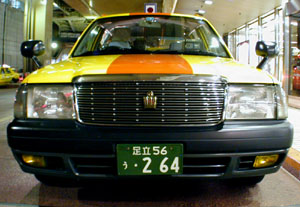 Statistics from the Tokyo Taxi Association show that the number of drivers and taxis on the roads of Tokyo's metropolitan area have slowly risen over the past decade. As a result, the coinciding sluggish demand has brought drops in revenue per day and occupancy rates.
Statistics from the Tokyo Taxi Association show that the number of drivers and taxis on the roads of Tokyo's metropolitan area have slowly risen over the past decade. As a result, the coinciding sluggish demand has brought drops in revenue per day and occupancy rates.
Nearly all taxi companies charged 660 yen for the initial 2 kilometers before last February's revisions to the Road Transport Law that eased regulations on fares and the limitation on the number of taxis free to roam Japan's roads.
The wheels of change first started turning back in 1993 when the government allowed small fluctuations in the total number of taxis. But the moves from last year essentially allowed for complete liberalization, opening the market to competition.
The goal is to force companies to cut back on the excess drivers and improve services. But the priority inherent within nearly all of Japan's "old guard" industries is to preserve jobs and prevent corporate bankruptcies. Like the practices at notoriously overstaffed construction companies, giving downsized corporate workers taxi jobs is the preferred means if the result is shorter unemployment rolls. Attempts at moving forward in this sort of environment then is nearly akin to stepping on the accelerator with the transmission set to "park."
One company in Fujisawa's neighboring city of Totsuka dropped its base fare to 320 yen after fare restrictions were lifted. But when drivers - whose salary is partly hinged on the revenue they generate - started quitting, the fare was quickly returned to the pre-deregulation level of 660 yen.
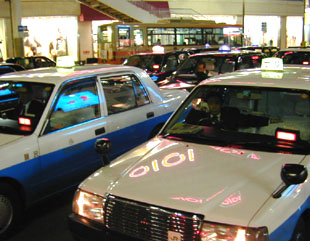 In Fujisawa, two new companies entered the market after deregulation. But, as Ugajin says, the companies agreed amongst themselves to freeze the minimum fare at 660 yen - the end result being more cars on Fujisawa's roads and any true competition left to spin its wheels.
In Fujisawa, two new companies entered the market after deregulation. But, as Ugajin says, the companies agreed amongst themselves to freeze the minimum fare at 660 yen - the end result being more cars on Fujisawa's roads and any true competition left to spin its wheels.
"The recession in general has made it more and more difficult to get passengers because less company workers are being provided with taxi fare vouchers," Ugajin explains. "Then deregulation added more drivers, making it extremely tough."
Attempting to increase revenue through various tools of the trade is nearly futile in these conditions. Though veteran cabbies are known to espouse theories on being able to visually distinguish a potential long haul, high paying customer from one requesting a mere short jaunt down the street, Ugajin maintains that it is impossible to tell the difference. "In the lineup in front of the station it just becomes like a lottery."
It wasn't always like this. Japan used to be a driver's market. As the economic bubble was inflating 15 years ago, stories of salarymen in Tokyo offering to pay two or three times the meter reading in an effort to entice a driver to pick them up were commonplace. Now all that is left from those fanciful days are, as Ugajin succinctly points out, "too many taxi drivers."
Fujisawa Taxi, which began operating 62 years ago, has taken some small steps to lure passengers in these tough times. This past December 24th and 25th, male drivers from the company played the part of Santa Claus, donning red stocking hats, red suits with white trim, and white beards, while handing out candles to passengers. For Valentine's Day, it was the female drivers' turn; they dished out boxes of heart-shaped chocolates.
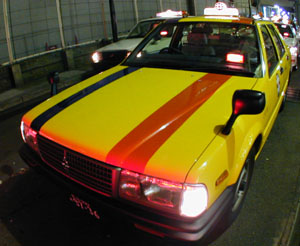 As layoffs from corporate downsizing become more and more common, the faces of the workforce are changing, too. With the average age of drivers having risen to the mid-50s, it is now getting to be a regular occurrence for passengers to be in the backseat of a former corporate warrior who has been driving less than a year. The days of when a driver used to make a 20-year career out of this profession appear over.
As layoffs from corporate downsizing become more and more common, the faces of the workforce are changing, too. With the average age of drivers having risen to the mid-50s, it is now getting to be a regular occurrence for passengers to be in the backseat of a former corporate warrior who has been driving less than a year. The days of when a driver used to make a 20-year career out of this profession appear over.
On the up side for Ugajin, who collects about 20 passengers a day during each of her 23 daytime shifts a month, she finds herself to be in demand more than most. Today Japan has just over 8,000 female drivers. This total has quadrupled since the days of its bubble economy 15 years ago.
In this traditionally male-dominated field, her presence in a blue vest, check-patterned necktie, and long-sleeve white oxford is soothing to customers; her boss has told her that customers find her pleasant demeanor preferable to the stereotyped arrogance and gruff disposition of male drivers known to be behind the wheels of Japan's taxis. She also possesses a keen knowledge of Fujisawa's streets from her prior days working for a delivery company - a rarity considering it is common to see drivers continually consulting maps to navigate Japan's confusing streets.
Even though she's seen her monthly salary fall by a full third since she began driving ten years ago, Ugajin plans on riding out any further tough times brought about by deregulation, seeing the security as a positive: "In the taxi business, people like me are not being restructured."
Coming Next Week: A look at the new breed shaping Japan's taxi industry. Note: Kazuko Maruyama and Kaoru Shimizu contributed to this report from the Yokohama Bureau.

